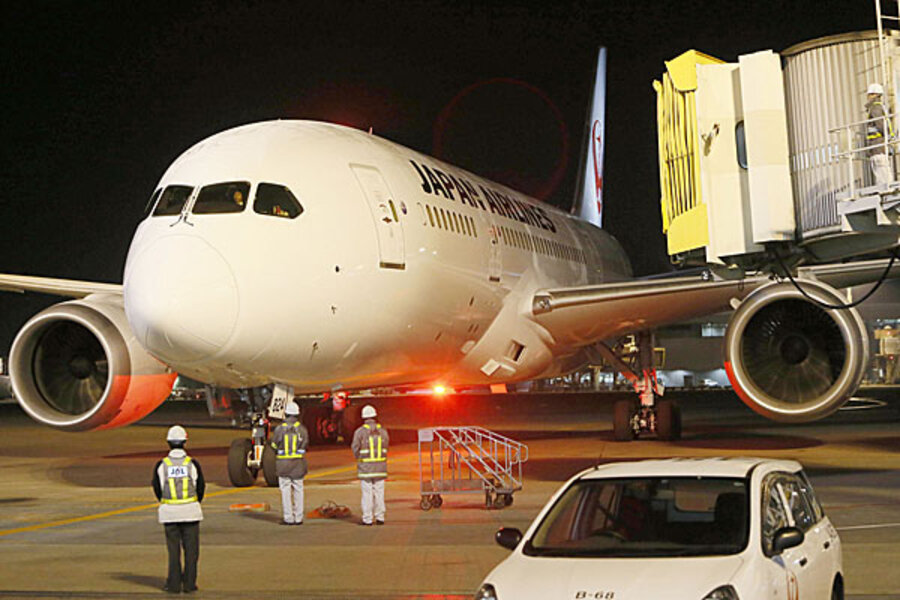Boeing 787 Dreamliner glitches: How serious are the problems?
| Los Angeles
Boeing faces a short term public-relations battle after a string of problems with its new 787 Dreamliner jet, but experts suggest that, so far, the glitches don't appear to be anything out of the ordinary for a new and highly complex aircraft.
While the cause of some of the problems is still unclear – and shares of the aerospace giant have fallen 2.6 percent in value – experts expect the episodes to be little more than a blip in the road.
“This should be no surprise whatsoever,” says Andrew Thomas, author of “Soft Landing: Airline Industry Strategy, Service, and Safety,” in an e-mail. “Every new complex collection of systems – and the Dreamliner is certainly that – will experience unknowns."
He suggests that "the magnitude, scale, and scope of the supply chain involved; the number of parts and systems; and the just-in-time nature of the manufacturing process guarantees that, like almost every other human endeavor, there will be imperfections and errors.”
This could be particularly true in the case of the 787 because it has so many new features – from the lighter, composite fuselage and wings to the electrical circuits that run the cabin to the lithium batteries that power them.
"This is basically an all electric airplane,” says Rob Mark, publisher of Jetwhine.com, in an e-mail.
But he and others say the recent glitches are likely to be dealt with in short order. “The two incidents so far don’t sound like bad design,” he adds.
Besides the Japan Airlines plane that began spewing smoke while at Boston’s Logan Airport Monday, there was a second Japan Airlines 787 that leaked fuel in Boston on Tuesday. Last month, a United Airlines 787 from Houston to Newark, N.J., had to be diverted because of electrical problems. Boeing has a backlog of more than 800 orders for the plane, and there are no indications that any have been canceled.
Not surprisingly, with its eyes on falling stock prices, Boeing is in full damage-control mode.
“I want to reiterate that we have extreme confidence in the 787 airplane and the 787 ideas. For a long, long time we looked at the airplane and there were so many things that we wanted to do,” said Mike Sinnett, 787 chief project engineer for Boeing, in a teleconference Wednesday. “We wanted to make an airplane that was more fuel efficient, more comfortable for passengers, and we wanted to give the airlines more flexibility. We’ve achieved those goals. We’re very, very happy with how it is performing.”
He says that, in terms of reliability, the rollout of the new 787 is similar to the rollout of the 777, which came out in 1997.
“The performance of both of these airplanes – the 787 and the 777 – has been better than any other new large wide-bodies that were introduced into the world’s fleets,” said Mr. Sinnett.
Boeing should remind the public that the 787 has been flying successfully for 15 months, public-relations experts say.
“This is not the time to go into crisis mode, but rather spotlight the safe record they have already been able to maintain,” says Ernest Del Buono, chair of crisis practice for Levick Strategic Communications. “They just need to stick to it and make sure people understand the huge number of hours flown and safety records already established, and that these are not issues with the aircraft itself in design or engineering.”
Others will be watching to find out whether the problems with the jet in Boston resulted from wiring – as reports are saying – or from the lithium ion batteries, which are state of the art but also potentially prone to overheating.
“If this smoke is a result of wiring, then why would the stock price of the battery manufacturer in Japan be taking a tumble?” asks Patrick Smith, an analyst at Aviation Experts. “Boeing doesn’t need to be put through the ringer about any of this, but the question should be posed. They know what they are doing, and they will fix this to satisfaction because that is what they are about.”





